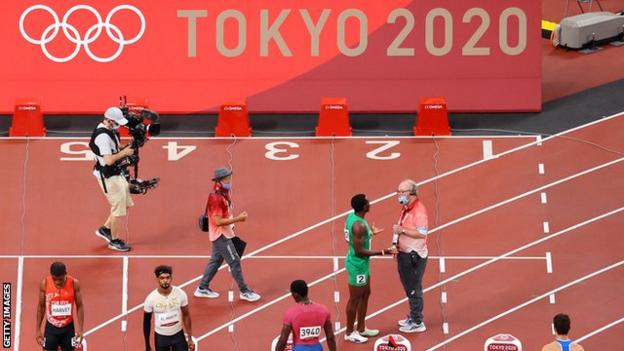Records continue to tumble on the athletics track at Tokyo 2020, with many citing the impact of “super shoes” and a springy Olympic track built for speed.
The three new world records set at these Games are already just one short of the final totals at Beijing 2008 and London 2012.
“With more than half of the athletics programme still remaining, another three improvements to world bests would make this the Olympics with the most new world records since Montreal 1976, when there were nine,” says Simon Gleave, head of sports analysis at Nielsen Gracenote.
So how much of a difference have the shoes and track really made in Tokyo?
Which records have been broken?
The USA’s Sydney McLaughlin smashed her own world record to win the women’s 400m hurdles on Wednesday – 24 hours after Norway’s Karsten Warholm did the same to clinch gold in the men’s 400m hurdles.
Rai Benjamin and Dalilah Muhammad, who finished second in the men’s and women’s races respectively, also beat the old records. Five of the women’s 400m hurdles finalists ran personal bests.
Double sprint champion Elaine Thompson-Herah claimed an Olympic record in the 100m and ran the second best time in history in the 200m, while Venezuela’s Yulimar Rojas set a world record as she won Olympic gold in the triple jump.
Shoes: technological progress or a step too far?
Many athletes are wearing super-light shoes containing a rigid plate and unique foam that lend a propulsive sensation to every stride.
Critics claim the shoes, first developed by Nike, are the equivalent of “mechanical doping”. Supporters hail them as a revolutionary advance after decades of stagnation.
“There seems to be an acceptance now that the new generation of shoes are part of the sport moving forward,” says Geoff Burns, a biomechanics and sport performance researcher, and an expert in running shoe technology.
But after winning gold on Tuesday, Warholm criticised runner-up Benjamin’s Nike footwear – and said he was working with Puma and the Mercedes F1 team on his own shoe.
“He had those things in his shoes, which I hate,” added Warholm. “I don’t see why you should put anything beneath a sprinting shoe. I think it takes credibility away from our sport.”
Speaking on BBC One, four-time Olympic gold medallist Michael Johnson said he doubted whether the “super shoes” gave an unfair advantage.
“I heard Usain Bolt say the other day if the shoes start to get too fast, that’s really unfair,” he said.
“I’d have a problem if the equipment starts to make the athletes faster than they actually are. We don’t want to see that.”
A track that gives athletes an edge
Designers of the track at the Olympic Stadium have added rubber granules to the 14mm track, while the lower layer has a hexagonal design that leaves small pockets of air.
Andrea Vallauri, the track designer, told the Guardian it provided “shock absorption and some energy return; at the same time a trampoline effect”.
“We have improved this combination and this is why we are seeing the track has improved performance,” he added.
He said the surface gave a 1-2% performance advantage to athletes, making it the quickest in history.

The track in Tokyo has also been given credit for assisting fast times
400m hurdles champion McLaughlin said after her record-breaking run that the track “gave you energy right back and pushes you and propels you forward”, adding: “It was really cool… to push the boundaries of what is possible.”
So, what’s the verdict?
It is clear the track is proving beneficial, although every Olympics sees organisers bid for innovation in the running surface.
The debate is more split on exactly how much the “super shoes” add, but athletes are saying they are having an impact.
However, World Athletics president Lord Coe said he was simply “viewing really talented athletes who are probably running quicker on fast surfaces”.
“For as long as I can remember we’ve had conversations about tracks that are fast and tracks that aren’t,” he added.
“Warholm is running fast but we’ve always known he’s running fast and he’s probably run a little bit quicker on this track. So have Sydney, Dalilah, Rai.”
Article from: https://www.bbc.com/sport/olympics/58084865





